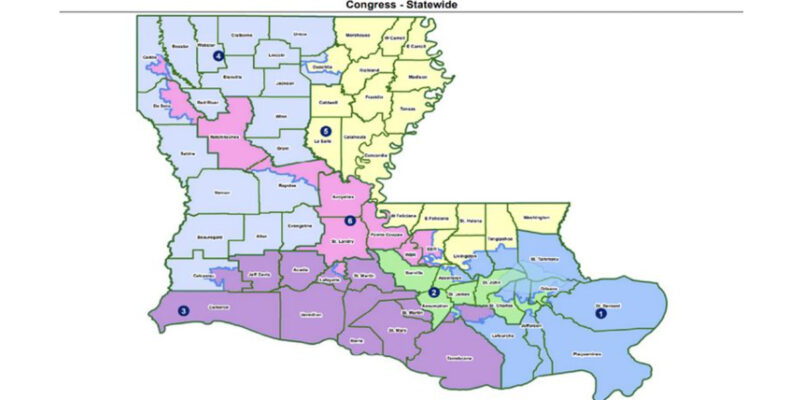WWL-TV has a piece up on a much-reported development in the Callais v Louisiana case at the Supreme Court which holds the promise of a potential end to court-enforced racial gerrymandering in congressional and other districts.
The U.S. Supreme Court announced that Oct. 15 is the date when justices are expected to hear additional arguments in the long-running legal dispute over whether Louisiana’s new congressional map is constitutional.
The high court will decide whether the map creating a second majority-minority district violates the Equal Protection Clause of the U.S. Constitution, which prohibits voting practices or procedures that discriminate based on race.
Attorney Tracie Washington represents the Louisiana Justice Institute, an intervener in the case.
“You know, this is going to be a tough one,” Washington said.
Yeah, she knows.
We’ve covered this a few times already, but the word we’re getting is that when the Supreme Court punted the case to this fall rather than making a decision on it back in June, the question wasn’t whether the current 6th District now represented by Cleo Fields should survive but whether this would be the case the Court uses to get rid of all the racial gerrymandering requirements states are saddled with.
Justice Clarence Thomas wrote a scathing dissent to the Court’s decision to punt the case making it very clear that he was ready to decide on the larger question. And the inside word we received had it that Thomas had Justices Alito, Gorsuch and Kavanaugh on his side in advocating for the Callais case to be the lever for getting rid of Section 2 of the Voting Rights Act of 1965 – which is the federal statute that lays the predicate for racial gerrymandering.
Back to Tracie Washington for a second…
According to Washington, the new districts reflect the racial makeup of Louisiana.
“In Louisiana, African American, black voters make up one-third of the voting age population,” she said. “We have six congressional seats allocated to us in Louisiana. One-third of that would be two.”
The new district, which stretches from Baton Rouge to Shreveport, is currently represented by Democrat Cleo Fields.
She’s correct in saying that’s how Section 2 of the Voting Rights Act is written, at least from the partisan Democrat perspective.
Except it’s a complete mess to apply that thinking to actual practice.
There is no region of Louisiana populous enough for a congressional district which is majority black. There are parishes in Louisiana which have majority-black populations, but they aren’t big enough, population-wise nor are enough of them contiguous in order to make it work without creating something ridiculous.
Like this. This is what the state legislature had to do to create two majority-black districts out of six…

That’s a stupid map. Everybody sees it’s ridiculous.
Could you make an argument that Louisiana could draw a better map and still get two majority-black districts? Yeah, you could, but come on. What level of torture is appropriate here when a 5-1 map is clearly what works for the majority of the people in the state?
And why is it, when there is zero current evidence that southern states are more racist than elsewhere when it comes to electoral politics, that we even need to continue all of this in the name of “civil rights?”
Section 2 is essentially a mandate for affirmative action for black Democrat politicians. It’s absurd in 2025, when you now have Virginia Lt. Governor Winsome Sears, who is black, in a race to be governor of that state as the GOP nominee. Last year Mark Robinson, who was North Carolina’s Lt. Governor, was the GOP gubernatorial nominee. Robinson lost, as did Kentucky Attorney General Daniel Cameron when he ran for governor, but most people seem to think Congressman Byron Donalds, whose district is mostly white, is going to be Florida’s next governor.
Tim Scott is a senator from South Carolina. Wesley Hunt is a congressman from Texas. John James is a congressman from Michigan. Burgess Owens from Utah. We could go on and on naming black Republican politicians who’ve succeeded in front of a majority-white electorate. It isn’t even newsworthy anymore when one gets elected. Hell, Ilhan Omar’s district in Minnesota is more than two-thirds white and she has no trouble getting elected there despite clear evidence she shouldn’t be.
Knowing this, it’s pretty telling that the Supreme Court a couple of weeks ago instructed the parties in the case to prepare arguments on Section 2. That’s a sign John Roberts and/or Amy Coney Barrett are willing to join the other four depending how it goes on Oct. 15.
All of which is bad news for Fields. At least he managed to get vested in Congress’ pension plan by serving his current term.
The question is whether there will be enough time to draw a new map after the Supreme Court decides the Callais case and still have a party primary as prescribed in law. Right now, qualifying is set for Jan. 17, and there is some thought out there that the Court will hand down a decision by Halloween.
Secretary of State Nancy Landry has said she needs a map by September in order that her people can process the changes and get ready for the party primaries in late March. But we’re hearing that’s not a hard-and-fast deadline.
We’re hearing this can all be done in November with a special session of the Legislature after the Supreme Court blows out Section 2, and Louisiana’s 4-2 map along with it.
Which scares the hell out of Tracie Washington. And from her point of view, maybe it should.
Washington is concerned that a Texas push to add five new Republican congressional seats may play a role in the Louisiana case.
“The Supreme Court can’t say what happened in Louisiana was wrong, but what’s happening in Texas is right,” Washington said.
Actually, yes they can. They can say state legislatures can draw whatever the hell kind of maps they want, knowing that the public will ultimately have our say about their work product.
Like Barack Obama said, elections have consequences. In blue states like Illinois and Massachusetts, they applied that rule as aggressively as they could when their majority-Democrat legislatures drew up their current insanely-gerrymandered maps. Louisiana’s Republicans are no less legitimate or justified to act in the exact same way to further the interests of their voters.
Ditto for Texas.
We’ll see if Gov. Jeff Landry and the Louisiana legislature are willing to be as aggressive as their counterparts across the Sabine. We’ll say, from the conversations we’ve had, that the people who elected them are passionate in demanding that they show just that.
Advertisement
Advertisement

